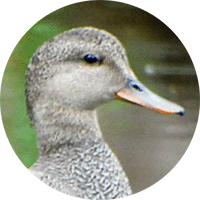Gadwall Duck
Appearance: Gadwall Ducks (43 cm - 17 inches) are gray with black rear end. Females are brownish, thin bill, orange only on sides, and yellow legs. In flight both sexes show white patch on inner secondaries.
Habitat: These ducks are commonly observed in mixed flocks with other dab ducks, such as teal, pintails, and shovelers. The flocks can be spotted foraging in the shallow waters, wetlands, engaging in characteristic dabbling behavior, where they upend their bodies to feed on submerged vegetation and invertebrates. These birds seek refuge in wetlands to escape harsh winter conditions further north. During their visit, these ducks exhibit similar characteristics and behavior as their counterparts in other parts of the world. They have preference for calm freshwater habitats, often near vegetation-rich areas, where they can find food and shelter.
Conservation: The Gadwall Duck is considered a species of Least Concern status by the International Union for Conservation of Nature (IUCN).
Distribution
The Gadwall duck is a visitor to San Andrés Island
Taxonomy
- Kingdom: Animalia
- Phylum: Chordata
- Class: Aves
- Order: Anseriformes
- Family: Anatidae
- Genus: Mareca
- Species: Mareca strepera
Vocalization
Whistling Calls: During courtship displays and interactions between males and females, Gadwall ducks may emit soft whistling calls. These calls are often subtle and gentle, sometimes described as a low, melodic whistle. They are used as communication signals between mates.
Grunting Calls: When engaged in territorial or aggressive interactions, males may produce low-pitched grunting calls. These sounds are used to establish territories or to defend mates during courtship.
Contact Calls: Gadwall ducks may use contact calls to maintain communication with other ducks in their flock or with their offspring. These calls are often short and soft, serving as a way to keep the group together or to signal their presence.
Alarm Calls: When sensing danger or perceiving a threat, Gadwall ducks may emit high-pitched alarm calls. These calls can be sharp and rapid, alerting other ducks in the vicinity to potential hazards.




